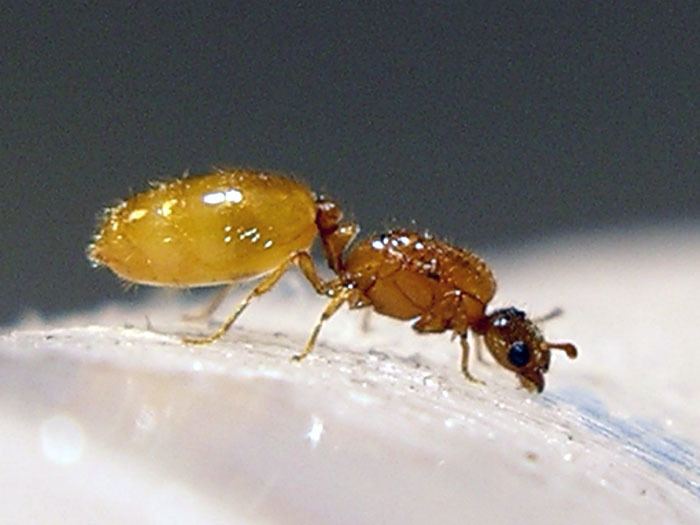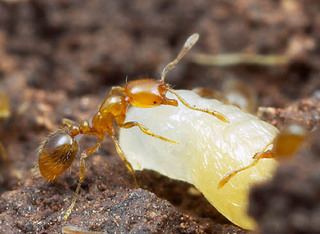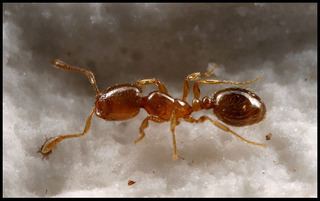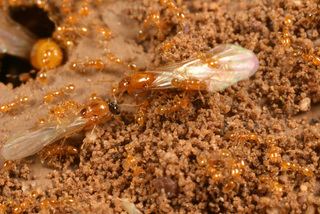Family Formicidae Scientific name Solenopsis molesta | Genus Solenopsis Rank Species | |
Similar Tapinoma sessile, Pavement ant, Pharaoh ant, Little black ant, Southern fire ant | ||
Solenopsis molesta
Solenopsis molesta, also known as thief ants, get their names from their habit of nesting close to other ant nests, from which they steal food. They are also called grease ants because they are attracted to grease.
Contents
- Solenopsis molesta
- My solenopsis molesta colony thief ant
- Appearance
- Distribution
- Habitat
- Behavior
- Mating
- Diet
- Problems
- References

My solenopsis molesta colony thief ant
Appearance

S. molesta range anywhere from 1/32 of an inch (0.5 mm) to 1/8 of an inch (3 mm) long. They can be yellowish or brownish tones of color. These ants have a two-segmented petiole connecting their abdomen to the thorax. They have 10 segments in their antennae, which end in large segmented clubs. Thief ants have small stingers on their oblong abdomen, and generally have small eyes. Worker ants have large jaws for carrying food back to the colony.
Distribution

S. molesta are native to the United States. They can more commonly be found in the central states and the east coast.
Habitat

The habitat of Solenopsis molesta is vast, because they can survive just about anywhere. They can live in people’s homes, in the cracks or under the floorboards. They can build nests anywhere, such as under rocks, in any exposed soil, and rotting logs. If they cannot find any of these things, then they move into another colony. Their nests are generally large for the ants’ size, and have tunnels that lead to another ant colony for a reliable and steady food source.
Behavior

Colonies of S. molesta usually have anywhere from a few hundred to a few thousand workers. Colonies have multiple queens. The number of thief ants in a colony depends on the location. Colonies with a reliable and ready food source don’t have as many workers because food is readily available. Since ants of this species are so small, they can colonize just about anywhere. They can live in people’s homes without them ever knowing that they have an infestation of tiny ants. Solenopsis molesta are common in homes, and due to their small size they can easily enter sealed packages of food. Other thief ant colonies are inside other ant colonies. They then eat the food and sometimes larva of the host ants. They will eat just about anything, including dead animals and fungal spores, and will travel great distances in search for food. Once food has been found, a trail is formed from the colony to the food so the other thief ant workers can find it.
Mating

S. molesta queens are bigger than the workers, being four to five millimeters long. Mating takes place from July to late fall. Both the queens and S. molesta drones have wings, and mating takes place while flying. Queens sometimes fly with a worker or two clinging to their bodies, presumably to help out right away when the queen finds a suitable place for a colony. Queens can lay anywhere from 27 and 387 eggs per day. The average number of eggs laid per day is 105. It takes about 52 days for an egg to become a fully mobile worker. Young Solenopsis molesta spends about 21 days in the larval stage when the weather is suitable.
Diet
They eat grease whenever they find it, which is why they are sometimes called grease ants. They also eat meat, cheese and other dairy products, and seeds. They also eat larvae and pupae of other ant species. Thief ants do not appear to be attracted to sweets, unlike most other ants. They will however, for example, consume fruits and sugary soft drinks.
Problems
Solenopsis molesta can be troublesome when they get into human dwellings. It is extremely hard to find these ants, due to their inaccessible and remote nesting areas and their extremely small size. They are also not always present outside their colony, and travel far to find food. Also, they are so small they can get into things that other insects can’t get into. The easiest way to locate a colony is to look for trails of ants. It is also hard to get rid of a S. molesta infestation because they are not attracted to common ant traps. One of the most common ways to get rid of the ants is to put oil or grease in the middle of the ant trap. However, this is a hit-or-miss method, because too little grease will not attract the ants, and too much will limit the effectiveness of the trap. The ants also appear to be resistant to most insecticides. Solenopsis molesta are sometimes mistaken for the pharaoh ant, because there are similarities between the two. They are both around the same size, but there are differences in their markings.
